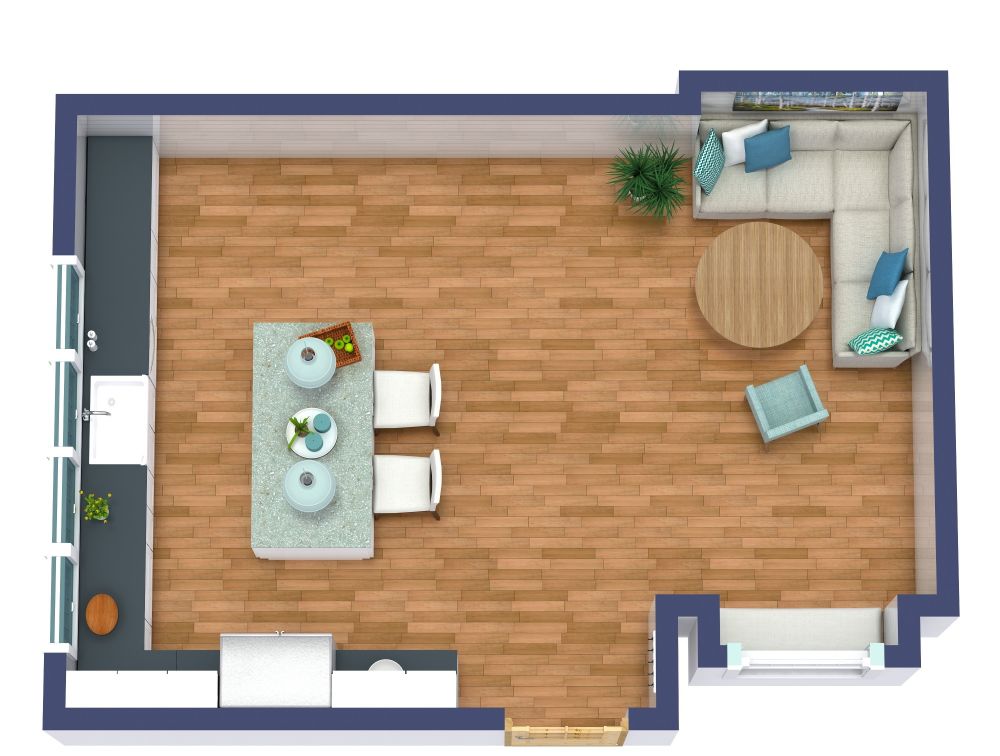Island Kitchens
A kitchen layout that includes an island can enhance your home in a variety of ways - extra workspace, additional storage, room for that new appliance, and more seating capacity. Plus, that kitchen island often becomes a fun social gathering place for friends and family, and it can also be a useful homework hub or work area. For these reasons and many more, kitchen layouts with islands remain very popular, both for new builds and remodel.
Read More
About Kitchen Islands
A kitchen island is a freestanding or floating unit with access on all sides - in other words, it is not connected to the walls or other countertops. This is in contrast to a "peninsula", which is similar to an island but is connected on one side.
Kitchen islands work particularly well in these types of kitchens
- One-wall kitchens, where all the appliances are on one wall
- U-shaped kitchens, which have 3 sides
- L-shaped or 2-sided kitchens
Galley kitchens, where two rows of cabinets face each other with an aisle in between, are usually not wide enough for a kitchen island.
Typical Island Dimensions
The island's size will depend on the size of your kitchen and what you want to achieve with the island. Our top tip is to consider scale. A very small kitchen island won't look good in a very large kitchen. Conversely, a large island won't look good, or even fit, in a small kitchen. A guideline some designers use is that the island size is about 10% of the size of your kitchen. So, for a 100 sq ft (10 m2) kitchen, the island could be around 10 sq ft (or 1 m2).
The minimum size for a built-in kitchen island is usually defined as:
- 24 x 48 inches (about 0.6m x 1.2m) for a rectangular islands
- 40 by 40 inches (about 1m x 1m) for a square island
As far as height, an island will usually be either 36" (91 cm), which is standard kitchen countertop height, or 42" (107 cm) which is bar height.
If you want the kitchen island layout to include a breakfast bar or eating area, a good rule of thumb is to allow 24 inches (60 cm) of space per person. In this scenario, you will also want an overhang on the seating side, to allow for knee space. A 12" (30 cm) overhang is pretty standard. Much deeper and you'll need support or an extra bracket for the overhang.
Aisle space
Adequate aisle space around a kitchen island is crucial. Two people may want to work back-to-back and also need to pass each other. Cabinet doors and drawers on each side of the aisle need to be able to fully open. The dishwasher door must swing all the way down.
A common recommendation is 40 to 48 inches (or approx 1 m) of aisle space around the island. Occasionally you can go a little less - for example, near the fridge, a 36 inch (0.9m) aisle may work, to make it convenient to load or unload the fridge with the island in easy reach.
Kitchen Size Required for an Island
There's nothing worse than crowding your kitchen with an island. Imagine not being able to pass someone who is cooking in the kitchen. Or you can't walk past the dishwasher when its door is open. So an important step is to make sure you have enough space for a kitchen island.
To determine if an island can fit, subtract the needed aisle space from the width and length of your kitchen floor plan and see if there is enough space left for an island.
Typical Island Kitchen Layouts
As you create a layout for an island kitchen, it's key to think through which functions you want on the island and which functions will be along the wall. Once you've determined your needs, it's a good idea to make a prioritized list. From there, you can start thinking about the optimal island kitchen layout and how it fits with your overall kitchen floor plan.
Note that many islands have a "working" side, for food prep, and a "public" side for eating. The "working side" should be near the other key work areas in the kitchen. Place seats or stools on the "public" side, for casual meals and for guests to hang out while chatting with the cook.
To help develop a priority list, here are some of the most common uses for a kitchen island:
- Increase workspace, food prep space, and serving space
- Add extra storage
- Create a sink area
- Add under-counter appliances
- Add seating to use for casual meals, homework, and gatherings
- Add a stove or cooktop. Remember that this requires a hood or exhaust fan as part of the design.
Plan Your Kitchen Today!
Are you ready to start planning the layout of your island kitchen? It's a good idea to visualize it first. One simple way is to mock things up in person - for example, create an island out of large boxes to check the scale. Or visualize a kitchen with an island in the RoomSketcher App.